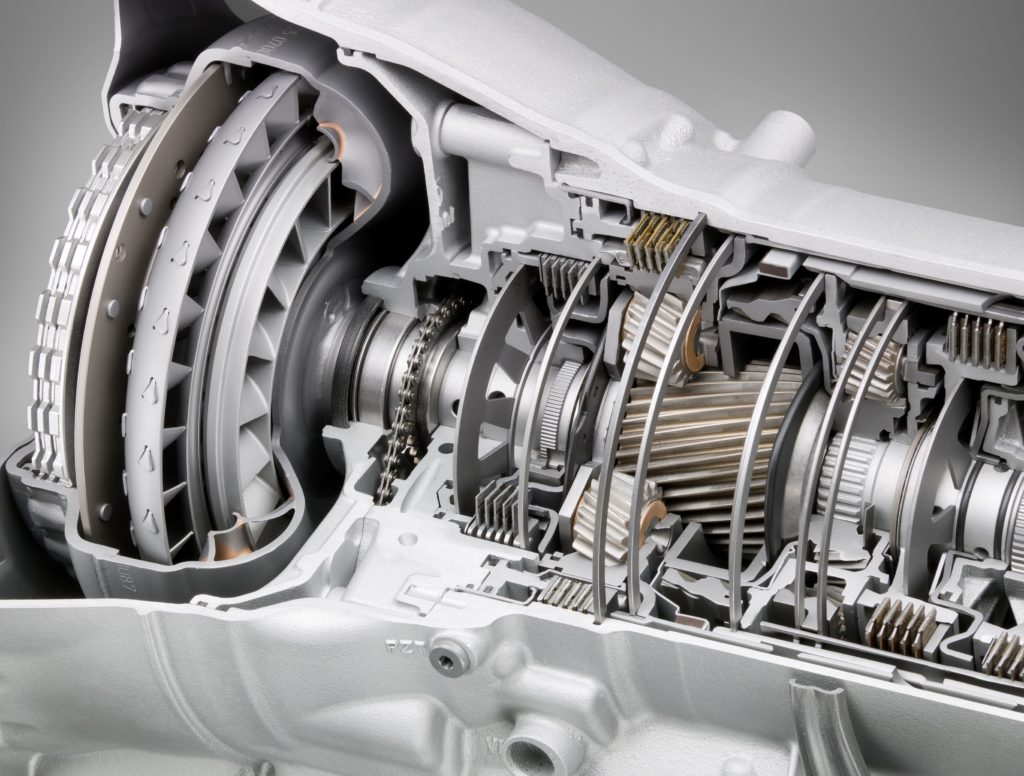
No matter what type of vehicle you drive, your transmission plays a critical role in getting you down the road. A transmission is what adapts and sends the power made by the engine to the wheels that drive the car. When referring to an automobile “transmission”, most often are people specifically mean the gearbox itself, which provides controlled application of power through gearing and allows your car to travel efficiently at a wider range of speeds without bogging down or over-revving your engine. However, sometimes (more commonly in the UK) it may be used to denote the entire drivetrain which could include the clutch, driveshaft, differential and any other parts of the vehicle used to transmit power from the engine to the wheels.
There are many different types of transmission designs, however the ones most commonly used in modern automobiles include “manual” (sometimes called “stick shift” or “standard”), “automatic”, “continuously variable (CVT)” and “dual clutch (DCT)”. For the purposes of this article, we won’t be diving into the nuances of each design, but rather reviewing the most common symptoms that you might encounter during your ownership which are tell-tale signs that your transmission needs repairs.
Given the importance of a properly operating transmission in getting you safely to your destination, you should remain alert for any of these signs that indicate your transmission is not in optimal health. While not all transmission troubles are preventable, a recent report by the experts at Auto Service Online estimates that 90 percent of them are due to low levels of transmission fluid or bad fluid. Ignoring the issues and warning signs that arise or procrastinating repairs most often will only make the problem worse, possibly leading to more expensive repairs or making your car entirely inoperable. Regular transmission service such as a fluid flush can help prevent major transmission repair or replacement.
Below are the top 9 signs that your BMW, Audi or Mercedes needs transmission repairs.
1) Transmission won’t go into gear or engage
If when you attempt to put your transmission in gear – such as sliding the shifter from Park (‘P’) to Drive (‘D’) in an automatic transmission (with your foot on the brake pedal), or attempting to select a gear with a manual transmission – and the shifter won’t slide into place to engage a gear for the car to move, then you should seek assistance from a mechanic and will likely need to get your vehicle towed. One common culprit for this problem that you can check for yourself on many vehicles is your transmission fluid level using the dipstick. If your vehicle is indeed low on transmission fluid, you may be able to top it off to the appropriate level and try again to engage the transmission, however this may be difficult to do on more complicated modern cars which sometimes require specialized tools. Your transmission problems could also be caused by issues with the shifter, cables, computer or electrical faults, or the failure of several other parts depending on your specific vehicle’s design. A local German auto mechanic will be able to help you diagnose the specific problem and figure out the best course of action for repairs.
2) Slow or clunky shifts between gears
If your automatic transmission is taking longer than normal to shift between gears, or the shifting as you drive feels particularly rough or clunky, something is wrong. You may be low on transmission fluid, which aside from affecting the smooth performance of the gearbox, can result in overheating and internal damage. When you experience this type of sloppy shifting, stop or minimize your driving until the problem is diagnosed and resolved. Be sure to check your fluid level as soon as you can and if you are comfortable doing so, you can top off the trans fluid and take a test drive to see if that solved the problem. In modern vehicles, your car might also display some type of warning that either the transmission is low on fluid or is overheating. These symptoms could also result from an engine-related issue that causes the vehicle’s computer to prevent the transmission from shifting into higher gear as a safety precaution.
3) There’s a leak under your car
While that mysterious fluid that’s been pooling under your car in the driveway could be one of the many types of vehicle fluids, it is definitely worth looking to see (or having a mechanic check) where the leaks are coming from. Transmission fluid is critical, as it provides lubrication for fast-moving internal parts of your gearbox, prevents overheating and in some transmission types is used to hydraulically engage and shift between gears. Transmissions can develop leaks when seals, lines or gaskets wear out or are otherwise damaged. While transmission fluid is most commonly red in color and often has a sweet smell , not all types of trans fluids look and smell the same. You may be able to still drive while you have a transmission leak, but you should closely monitor the fluid level and address the issue as soon as possible to prevent further damage.
4) Smells like burning
If you are catching whiffs of a burning smell while driving, you should take your car to a mechanic right away. If the smell has the scent of burning rubber, your transmission is may be overheating and/or leaking, which is causing the trans fluid to break down and burn off. Overheating is most commonly caused by low fluid levels, clutch debris, metal components breaking down or from sludge that has built up inside the transmission. If your transmission fluid has not been changed over a long time period of time or miles (reference your owner’s manual for the maintenance schedule), this can be a common outcome. Once the fluid is burnt, it no longer can do its job to lubricate parts, hydraulically shift between gears and regulate heat.
5) Acceleration is inconsistent and engine is revving high
If when you attempt to accelerate, your engine revs higher than normal without the expected accompanying increase in speed, the power delivery is inconsistent, or you feel like you are generally low on power, then a clutch in your transmission might be slipping. This type of issue poses a serious safety hazard as your vehicle is no longer completely under your control and you may experience erratic acceleration or complete loss of the ability for your car to move at all. This condition can also be caused by low transmission fluid, contamination of the fluid due to lack of maintenance or water intrusion, or internal wear and tear on the parts inside the transmission. If you experience this in your car, you should immediately go to a mechanic or get towed.
Modern transmissions may prevent you from recklessly driving with a damaged transmission by going into a “limp mode” or “safe mode.” The computer system will detect a problem with the transmission and may restrict shifting and the engine’s power output, often operating only in one gear as a safety mechanism to allow the driver to get safely to a repair shop where the mechanic can check the computer’s trouble codes to isolate and diagnose the issue.
6) Hearing Strange Noises
It’s never a good feeling to hear a new weird noise coming from your car. While vehicle noises differ, common sounds from a transmission in trouble include buzzing, clicking, clunking, whining, humming or roaring while driving. If one or more of these sounds are present while driving, the best case is that your car is in need of fresh transmission oil. Alternatively, your transmission might have a bad bearing, damaged gears, or other internal problems. A buzzing sound could also result from a bad internal seals and low transmission fluid due to a leak.
If the sounds you’re hearing are ones that you have never heard before, you should take your car to a local mechanic or transmission specialist ASAP. These noises are more than just an annoyance, they are tell tale signs that something is mechanically wrong with your vehicle. Ignoring them or hoping they’ll go away on their own will most likely only make matters worse in the long run.
7) Shaking, Jerking or Grinding
If you are driving along and your car starts to jerk and shake, something is obviously wrong and it very well may be a problem with your transmission (particularly with automatic transmissions). As there can be other causes for these symptoms, such as failing engine and transmission mounts, the best way to diagnose the issue is by bringing your vehicle to a transmission repair expert immediately to determine the true problem. Continuing to drive with these symptoms present will likely cause further damage.
Drivers of manual transmissions are most likely familiar with the gut-wrenching grinding sounds that can accompany a bad shift, but if your manual transmission consistently grinds when shifting gears that is typically a condition related to the low fluid levels, the clutch not releasing, the synchronizers inside the transmission being worn or broken, shifter wear or an adjustment problem. Check your fluid levels immediately and then take your car to a mechanic for further diagnosis.
8) Clutch pedal is engaging much higher or lower than normal
Often referred to as a “dragging clutch”, if your clutch pedal (in a car with a manual transmission) starts to grab and engage much sooner or later than normal in the pedal’s range of motion, it can make changing gears difficult or impossible. This condition happens when the clutch disc and flywheel don’t engage and disengage properly when the clutch pedal is pushed and may result from a problem with the linkage or the hydraulic system that operates the clutch. In some cases, a manual transmission might also “pop out” of gear during gear shifts.
Typically a clutch pedal that engages very low has a problem with the linkage or hydraulic system. A clutch pedal that grabs very high is most often associated with a worn clutch disc and pressure plate that need replacing.
If you experience these problems, you may be fortunate and only need a simple adjustment or fluid change. You should also have the master and slave cylinder inspected at this time, as they control the hydraulics between the clutch pedal and the actual clutch disc’s engagement to the engine’s flywheel and are a common source of misdiagnosis.
9) Check Engine Light & Computer Warnings
A check engine light (CEL) does more than just alert you to a potential problem with your engine – it can also give you a heads up when something is wrong with your transmission and other parts of the vehicle. Some cars might also have a dedicated transmission warning light and modern cars may display digital text readouts of warnings and error messages. Regardless of how the message is delivered, you should not ignore it and either scan the trouble codes yourself using an OBD-II reader or have a mechanic do so for you. This will give you a better starting place for diagnosing the problem(s).






